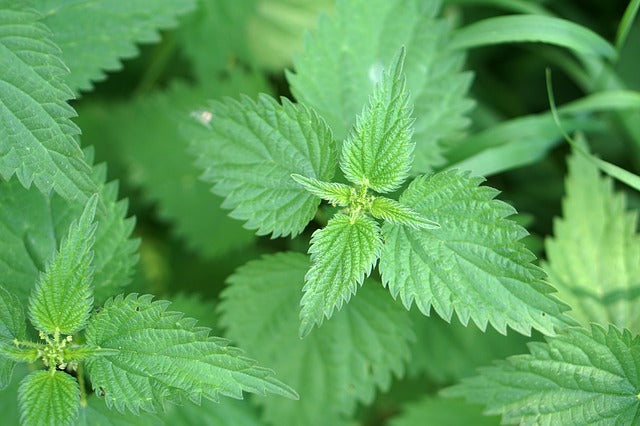Nettles for Bones and More!
May 11, 2010 4 min read

If you have ever tangled with the stinging nettle plant while on a hike, then you know the encounter can bring a bout of severe pain. The leaves and stems are very hairy with both neutral and stinging hairs. When touched the tip transforms into a needle that injects several chemicals. The pain and itching from a nettle sting usually lasts around 20 minutes, and for some the irritation lasts a day or two.
However, nettles also have many benefits. Once nettles are dried or cooked they lose their bite and can be used as a tea or added to a variety of recipes such as soup, polenta and pesto. Nettle soup is a common use of the plant, particularly in Northern and Eastern Europe.
Since they contain silica nettles may improve your hair, nails and skin. If prepared correctly, nettle tea is high enough in calcium to be considered an aid in bone-building. Some of the other conditions it may help include insomnia, osteoporosis, arthritis, adrenal depletion, skin conditions, indigestion, low iron and even headaches.
Stinging nettle is a valuable spring tonic that can support our immune system, spleen, circulatory system, urinary tract, nervous system, respiratory tract, digestive system and endocrine system, including the adrenals, thyroid, and the pancreas. Some of the conditions it can treat include:
- Leg cramps
- Excessive menstrual bleeding
- Assists in cold and damp health conditions
- Supports bone health
- Support of hypothyroid and adrenal fatigue
- Chronic respiratory conditions
- Digestive and urinary tract illnesses that involve mucus
- Hay fever and asthma
When treating a chronic condition check with your health care provider to make sure that daily use of nettles is not contraindicated. I have used this herb personally and with patients for many years and found it to be both safe and beneficial.
Nutrients found in nettles:
- Calcium – According to some sources, one cup of infused nettles contains 300-500 mg of calcium. I am looking for a definitive reference on this, so if anyone knows of a study, pass it along!
- Silica – Great for bones, connective tissue, hair, nails and skin.
- Carotene
- Magnesium
- Vitamin A
- Chromium
- Vitamin B
- Potassium
- Zinc
- Vitamin K
- Protein - Stinging nettle also contains a high amount of protein for an herb.
Simple nettle tea or nettle tea infusion
The best way to make nettle tea for its medicinal properties is to prepare it by infusion or by simmering. Infusions significantly increase the nutrient value of the tea by allowing more of the minerals to release into the liquid. Simmering the tea (see below) will aid in releasing more minerals from the leaves.
Nettle tea infusion
Make sure that you purchase the freshest nettles that you can find. If they grow locally pick them (with gloves).
- Place 1 oz. of organic dried nettles in a glass, quart-sized jar. Canning jars work well for this, and it will be just under half-full of the dried nettles.
- Pour just-boiled water (preferably without chlorine or fluoride) over the nettles, filling the glass jar to the top. Cap snugly, but not too tight.
- Let it steep for 4 hours or overnight. After four hours the infusion is ready to drink, but for maximum benefits leave the nettles in for up to 24 hours before straining.
- Strain the nettles out, squeezing any excess from the plant material, and store your infusion in your refrigerator for up to 3 days.
- Discard the leftover nettles in your compost or under your trees and bushes--it will help them stay healthy, too!
- Drink 1 cup to 1 quart daily. If that sounds like a lot, remember that it’s one less quart of water you need to drink!
You can drink the infusion iced or heated, depending on your preference and the time of year. Heated is always better than iced for digestion. My favorite way to drink it is to fill a cup halfway with nettle infusion and then top it off with boiling water. What I end up with is warm tea. If you want hot nettle infusion, warm it over the stove. Avoid microwaving it, as it destroys nutrients.
If those instructions seem overwhelming, don’t be dissuaded from making this wonderful tea. You can also purchase organic nettle tea in a tea bag. Let the tea steep a long time and leave the bag in the cup so that more of the nutrients will leach out into the water. Try it without sweeteners—nettles have a mild earthy green taste similar to light spinach.
Simmering nettles to extract minerals
Make a strong decoction from the tea to extract its minerals. Usually leafy items are infused, but to extract minerals you need to decoct or simmer tea for a minimum of 30 minutes.
Dosage: One or two heaping tablespoons per cup of water simmered for 30 minutes. This dose can be consumed 1-4 times per day. Always start slow with any new herb and work up to stronger doses.
Nettle side effects
Although rare, allergic reactions to nettle have been reported. Stop taking nettle and seek emergency medical attention if you experience symptoms of a serious allergic reaction including difficulty breathing, closing of your throat, hives, or swelling of your lips, tongue, or face.
Other less-serious side effects are also uncommon and may include mild upset stomach.
Resources: Susun Weed, Claire Swain and Susan Mead
Subscribe
Sign up to get the latest on sales, new releases and more …

